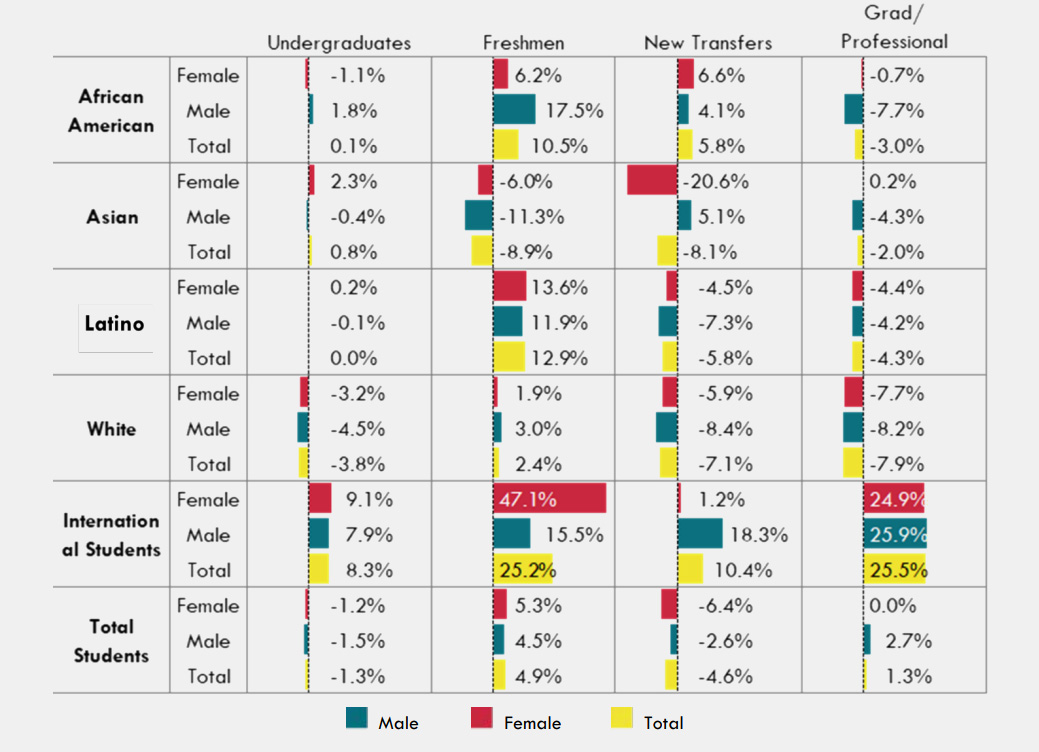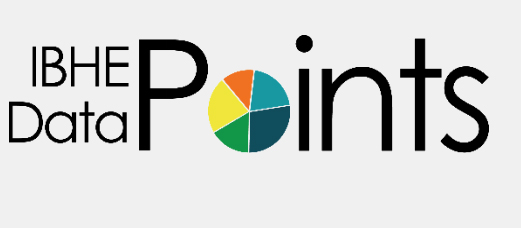
IBHE FIRST LOOK – FALL ENROLLMENT 2022-23
Highlights
-
Illinois’ Fall 2022 enrollment is ahead of several national trends¹ despite slight overall decreases in undergraduate enrollment.
-
In Illinois, enrollment of African American freshmen increased by 10.5%, which was significantly higher than the nationally reported decrease of 4.3%. African American undergraduate enrollment was flat year-over-year, which was better than the 3.5% national decrease.
-
Latino freshmen enrollment in Illinois increased by a robust 12.9% and was significantly higher than the nationally reported decrease of 0.7%. Latino undergraduate enrollment was flat year-over-year, which was better than the national 0.8% decrease reported for all public universities.
-
Graduate and professional enrollment at Illinois public universities increased by 1.3%, equating to an additional 719 students. This increase was better than the national annual -0.3% change in graduate enrollment for all public universities.
-
Freshmen enrollment at Illinois public universities increased by a noteworthy 5.0% year-over-year. This, too, bucked national trends which indicated a 2.4% decrease in freshmen at all public universities. Illinois did particularly well with African American and Latino freshmen.
-
Although public university undergraduate enrollment decreased 1.6% at the national level, undergraduate enrollment at Illinois public universities was down by slightly less at 1.3%, which equates to 1,705 fewer undergraduates year-over-year.
Overall, fall enrollment at Illinois public universities decreased by 0.5% from last fall.
-
More than eight out of every 10 (80.3%) new freshmen at Illinois public universities who were enrolled in the fall of the 2021-22 academic year were still enrolled in the fall semester of 2022-23. This represents a 1.4% decrease in retention from what was reported for freshmen from the prior year.
-
When disaggregated by race/ethnicity, there is more than a 20-percentage point gap in fall to fall retention between African American undergraduates (62.0%) and their white peers (83.8%).
Overview
IBHE has continued to collaborate with Illinois public universities to provide an early look at fall enrollment. Aligned with IBHE’s strong focus on equity as described in the new strategic plan for higher education, A Thriving Illinois: Higher Education Paths to Equity, Sustainability, and Growth, this report provides enrollment and retention data by race/ethnicity, as well as information on more nuanced enrollment types, like dual credit and new undergraduate transfers.
For the first time, year-over-year retention rates among the previous fall’s freshmen are included in this report.
¹ For all of the national comparisons, we used the following: National Student Clearinghouse Research Center. (October 20, 2022). COVID 19- Stay Informed with the Latest Enrollment Information. COVID-19: Stay Informed - National Student Clearinghouse Research Center (nscresearchcenter.org)
Total enrollment at Illinois public universities is higher than any recent year going back to 2018-2019 with the exception of the last academic year. As shown in Figure 1, in fall of 2022, there was a 0.5% annual decrease in total enrollment relative to fall of 2021-2022, equating to roughly 1,000 fewer Illinois public university students. After a few consecutive years of robust increases, growth in graduate and professional enrollments slowed down in 2022-2023 and could not make up for the 1.3% decrease in undergraduate enrollments.
Figure 1: Illinois Public University Headcount Enrollments from Fall of Academic Year 2018-19 to 2022-23
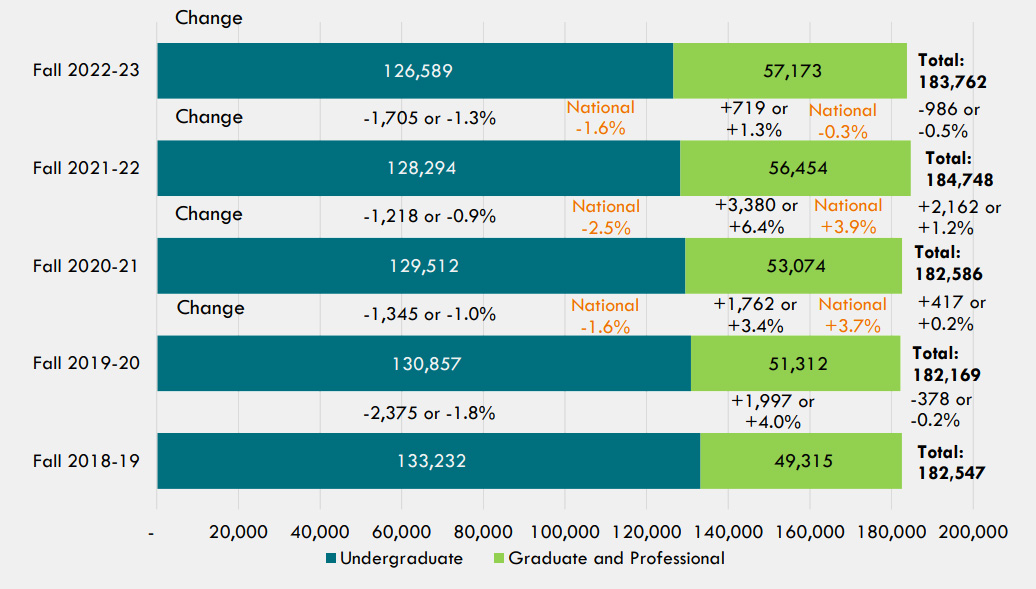
Undergraduate Enrollment. As shown in Table 1, overall undergraduate enrollment was down 1.3% in the fall of academic year 2022-23, which was a slightly larger decrease than the annual change in 2021-22 (-0.9%) and 2020-21 (-1.0%), but not quite as high as 2019-20 (-1.8%). This marks the fourth consecutive year of decreasing undergraduate enrollment at Illinois public universities and represents 6,643 fewer students relative to 2018-19 (See Figure 1).
New first-time, full-time undergraduates at Illinois public universities (generally freshmen) increased by nearly 5%, with a parallel proportional increase among dual credit/dually enrolled students. However, there was an overall decrease of 4.6% among new full-time transfer students while the percentage of continuing undergraduates was also down 2.6% year-over-year.
Table 1: Undergraduate Enrollment Type for Illinois Public Universities (Headcount)

Graduate and professional enrollment. As shown in Figure 1, graduate and professional enrollment at Illinois public universities increased by more than 700 students, representing a marginal 1.3% increase year-over-year. This growth was somewhat lower than the robust growth at the graduate and professional levels in previous years.
As undergraduate enrollments comprise a much larger share of overall enrollments at Illinois public universities (68.9%) and growth in graduate and professional enrollment leveled off, total enrollments at Illinois public universities were down by slightly fewer than 1,000 students compared to 2021-22.
Institutional Highlights and Detailed Enrollment
Dual Credit/Dual Enrollment. As shown in Table 2, dual credit enrollments were up by 4.9% (+123), driven by modest year over year growth at Eastern Illinois University (EIU) and large proportional annual growth at Northeastern Illinois University (NEIU) (+716.7%). EIU still accounts for nearly nine out of every ten (88.0%) of the dual credit enrollments among Illinois public universities. In fall of 2022-23, eight Illinois public universities reported dual credit/dual enrollment students, which was up from six universities the year before.
Table 2: Dual Credit/Dual Enrollment at Illinois Public Universities (Headcount)

Full-Time Undergraduates.
As shown in Table 3, nine out of the 12 public universities experienced growth in the number of first-time, full-time undergraduates or incoming freshmen in 2022-23 compared to the fall semester of last year. This fall marks the highest number of full-time freshmen at Illinois public universities from academic year 2019- 20, representing just shy of 25,000 new students. For Illinois public universities, 2022-23 is the second consecutive year with large annual growth in freshmen enrollment (+7.7% in 2021-22 and +5.0% in 2022-23). This recent growth occurred after a large annual decrease of 5.4% during the first full academic year after the start of the pandemic (fall of academic year 2020-21) and public universities overall have higher freshmen enrollment than the year prior to the pandemic.
The annual growth in freshmen enrollment was not limited to the larger Illinois public universities, as it marked the high-water mark for freshmen enrollment for several Illinois public universities including Governors State University (GSU), Illinois State University (ISU), Northern Illinois University (NIU), and Southern Illinois University Carbondale (SIUC). With nearly 4,000 freshmen, freshmen enrollment at ISU is significantly higher than any recent year and surpassed its pre-pandemic high in 2019-20. NEIU bounced back with nearly 500 new full-time freshmen in 2022-23 after a recent low of 314 new full-time freshmen in 2021-22. Southern Illinois University Edwardsville had its second largest full-time freshmen class in 2022- 23, down slightly from 2021-22. Freshmen enrollment at University of Illinois Urbana-Champaign is down from 2021-22 but well above its recent low in 2020-21 which was the first full academic year after the start of the pandemic. University of Illinois Springfield is at a low point in terms of new full-time freshmen, after experiencing its highest recent freshmen enrollment in fall of 2019-20, just before the start of the pandemic. University of Illinois Chicago experienced its second consecutive year of growth in freshmen enrollment but has yet to reach the level of its pre-pandemic high of 4,381 in fall of 2019-20. SIUC is approaching 1,500 new freshmen in 2022-23, with its third consecutive year of annual growth. This occurred after a recent low of slightly more than 1,000 new freshmen in the fall of 2019-20.
Table 3: First-Time Full-Time Undergraduates (Freshmen) at Illinois Public Universities (Headcount)
 at Illinois Public Universities (Headcount).jpg)
New Full-Time Transfer Students.
As shown in Table 4, new full-time transfer enrollments were down by 4.6% compared to last year, which equated to 456 fewer new transfer students across all of the Illinois public universities. Only four of the 12 Illinois public universities experienced year-over-year growth in new transfers, led by Chicago State University at 13.2%, UIS at 5.8%, EIU at 2.4%, and UIUC at 1.0%. Enrollment of new transfer students at ISU was mostly flat year-over-year. NEIU, NIU, and SIUC experienced double digit decreases in new transfer students of 14.8%, 12.5%, and 10.4%, respectively. This trend could continue as Illinois community colleges, which are the main source of new transfer students at Illinois public universities, have experienced overall decreases from fall of 2019-20 to fall of 2021-22 (-15.1%, representing a loss of nearly 41,000 students). However, enrollment at Illinois community colleges in fall of 2022-23 increased by 1.5% relative to 2021-22, representing an increase of 3,300 students. ²
² Data Source: ICCB Fall 2022 Enrollment Survey and ICCB Centralized Data System–Fall Enrollment (E1) Student-Level Submission for Fall 2019-2021.
Table 4: New Full-Time Transfer Students at Illinois Public Universities (Headcount)
.jpg)
Continuing Undergraduate Students. As shown in Table 5, there were nearly 2,300 fewer continuing undergraduate students comparing 2021-22 to 2022-23, a decrease of 2.6%. This was similar to the previous cycle’s decrease (comparing 2020-21 to 2021-22) of 2.9% and 2,634 fewer continuing undergraduate students.
All Illinois public universities, except UIUC, experienced a decline in the number of continuing undergraduate students. The year-over-year decreases in the percentage of continuing undergraduates ranged from 0.7% at SIUC to 13.2% at NEIU. UIC experienced the largest decrease in the number of continuing undergraduate students at 583, followed by NEIU at 438, and SIUE at 411.
Table 5: Continuing Undergraduate Students at Illinois Public Universities (Headcount)
.jpg)
Graduate and Undergraduate Enrollment Summary.. As shown in Table 6, total enrollment decreased by 0.5%, with a 1.3% decrease at the undergraduate level along with a parallel proportional increase (+1.3%) in graduate/professional enrollments.
Three of the 12 Illinois public universities experienced undergraduate enrollment growth: ISU at 2.2%, UIUC at 1.0%, and EIU at 0.2%. The marginal undergraduate enrollment growth at EIU was sustained by their modest growth in dual enrollment. NEIU (-8.7%), SIUE (-6.5%), and CSU (-5.3%) experienced the largest year-over-year proportional decreases in the number of undergraduates.
At the graduate level, enrollment in Illinois increased by 1.3%, although public universities saw a decrease of 0.3% at the national level. Seven of the 12 Illinois public universities experienced growth in graduate/professional enrollments compared to fall of 2021-22 and three more experienced marginal annual decreases; (SIUE at -0.4%; CSU at -0.1%; and UIUC at -0.1%). NEIU experienced the largest decrease in graduate/professional enrollment at 15.4%. UIS experienced the largest annual growth at 25.3%. EIU (+13.8%) and WIU (+13.2%) also experienced noteworthy double-digit growth in graduate/professional enrollment.
Table 6: Enrollments and Year to Year Change (Headcount)
.jpg)
Enrollment Patterns by Race/Ethnicity
African American Enrollments. As shown in Figure 2, overall African American student enrollment at Illinois public universities was down 0.6% to 20,426 students in 2022-23 and fell slightly below fall semester 2019-20 enrollment of 20,715 students. Undergraduate enrollments were mostly flat year-over-year (an increase of 17 students). However, this was better than the 3.5% decline in African American undergraduate enrollments that was reported nationally for all public universities. At Illinois public universities, graduate and professional enrollments shrunk by 3.0% to 4,719 students, which helped to drive the overall drop in African American enrollment at Illinois public universities. This decrease was slightly larger than the 1.9% decrease in African American graduate/professional enrollment that was reported nationally across all sectors.
Figure 2: Headcount Enrollment of African American Students at Illinois Public Universities
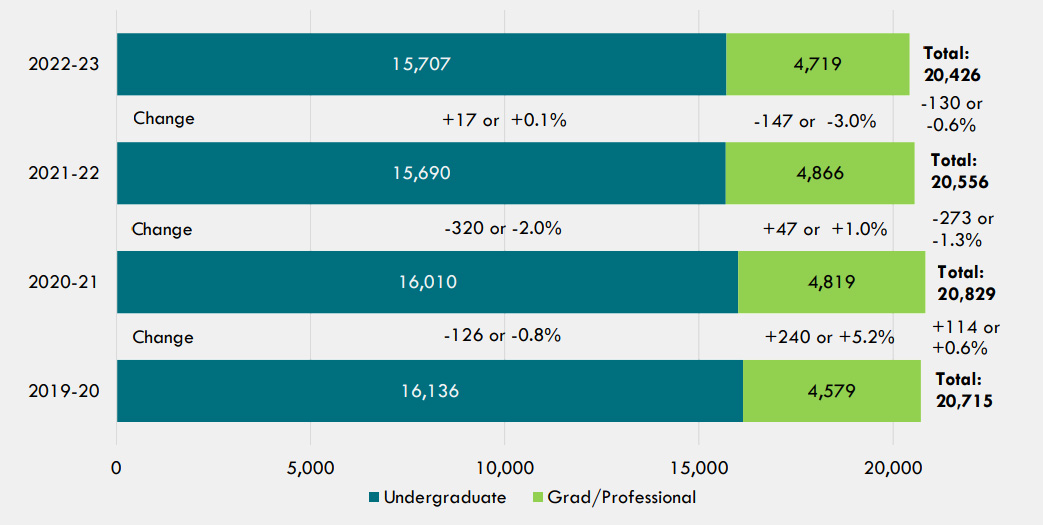
Latino Enrollments. As shown in Figure 3, total Latino student enrollment at Illinois public universities decreased by 0.7%, representing 210 fewer students from fall of 2021-22. This occurred after two consecutive years of growth. Latino undergraduate enrollment was flat, which was slightly better than the 0.7% decline in Latino undergraduate enrollment that was reported nationally for all public universities. At the graduate/professional level, after two years of large annual growth, Latino students experienced a decline of 4.3%. This decrease in Latino graduate enrollment was larger than what is being reported nationally across all sectors (-0.4%).
Figure 3: Headcount Enrollment of Latino Students at Illinois Public Universities
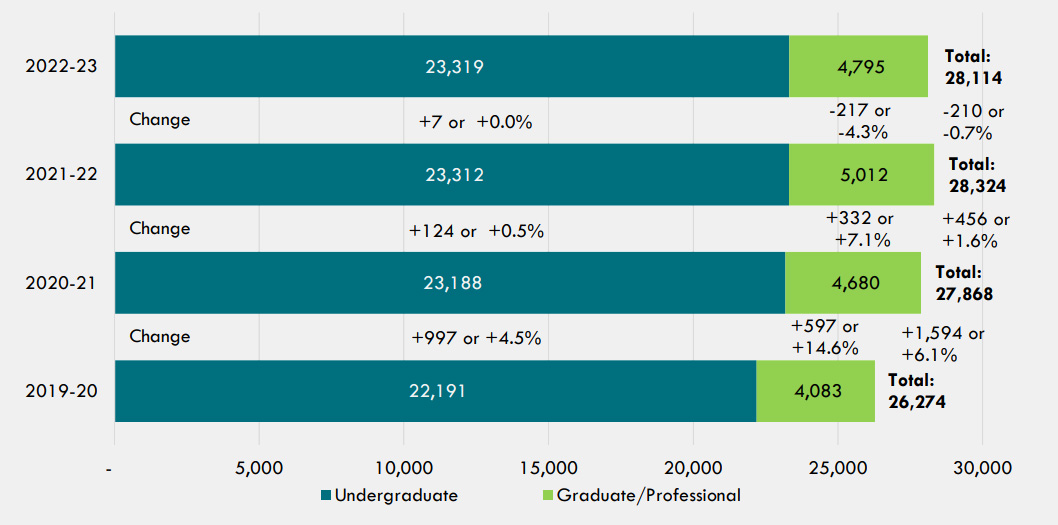
White Enrollments. As shown in Figure 4, overall, there were nearly 4,310 fewer white students enrolled at Illinois public universities, representing a fairly large enrollment loss of 5.0%. Undergraduate enrollment of white students was down 2,299 or 3.8%. This decrease was slightly worse than the -3.1% annual change in white undergraduate enrollment that occurred nationally. Since the fall of 2019-20, nearly 6,500 fewer white undergraduates enrolled at Illinois public universities. The year-over-year change in graduate enrollment at Illinois public universities was -7.9%, representing over 2,000 fewer white students. This too was worse than the national year-over-year change of -5.0% across all sectors.
Figure 4: Headcount Enrollment of White Students at Illinois Public Universities
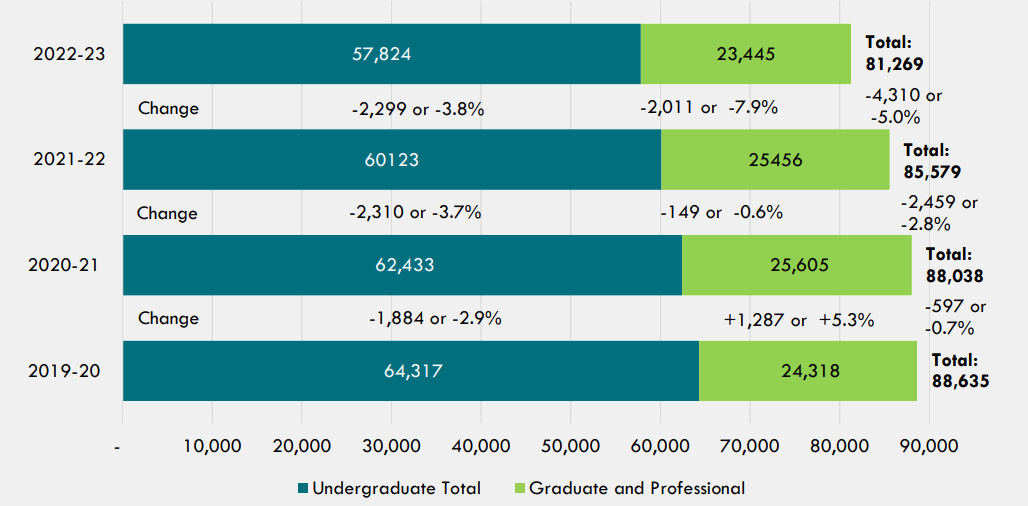
International Student Enrollments. As shown in Figure 5, after experiencing large enrollment decreases among international students in 2020-21 (-11.1%), overall enrollment of international students at Illinois public universities continued to grow at a significant rate with 19.0% year-over year growth for 2022-23. Illinois public universities experienced a robust increase in graduate and professional enrollments among international students (+25.5%), increasing proportionally more than undergraduate enrollments (+8.8%). The annual growth in undergraduate international students at Illinois public universities bucked the national trend across all public universities which experienced a 7.0% annual loss. The annual growth in graduate enrollment at Illinois public universities (+25.5%) was higher than what is being reported for international students nationally across all sectors (+15.4).
Figure 5: Headcount Enrollment of International Students at Illinois Public Universities
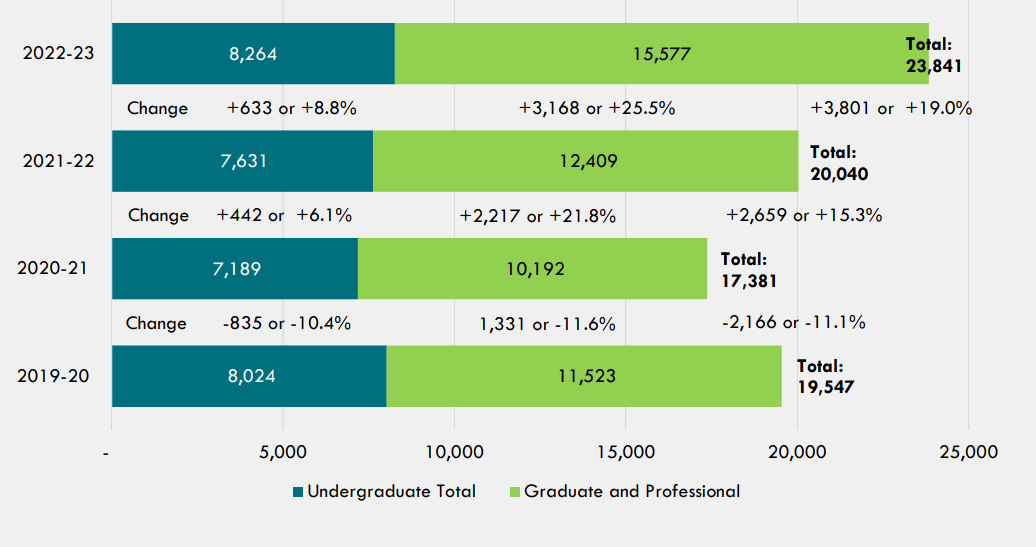
Fall to Fall Retention by Race/Ethnicity. As shown in Figure 6, more than eight out of every 10 (80.3%) new freshmen at Illinois public universities who were enrolled in the fall of 2021-22 were still enrolled in the fall semester of 2022-23 (reported as 2022). This represented a slight decrease from the prior year (change of -1.4%). However, once again, gaps emerged when retention rates were disaggregated by race/ethnicity. A retention gap of more than 20 percentage points was evident between African American undergraduates (62.0%) and their white peers (83.8%). The retention gap between Latino undergraduates and their white counterparts was smaller, at around eight percentage points. After Asian undergraduates (92.7%), international students had the second-highest rate (88.0%) of retention among all groups.
Figure 6: Fall to Fall Retention by Race/Ethnicity for Illinois Public Universities
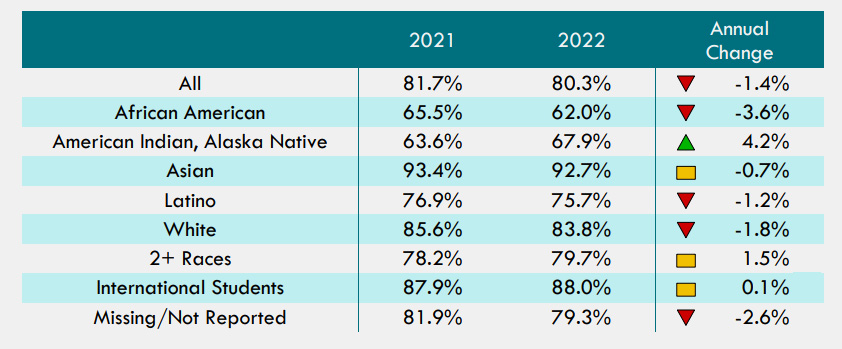
*A person who is not a citizen or national of the United States and who is in this country on a visa or temporary basis.
Fall to Fall Freshmen Retention. As shown in Figure 7, there was variation across the twelve Illinois public universities in terms of retention for new freshmen from fall of academic year 2021-22 to fall of 2022-23 (reported as 2022) in addition to the variation that was reported last year for the group of freshmen from fall of academic year 2020-21 to fall of 2021-22 (reported as 2021). CSU and GSU experienced comparatively large increases in freshmen retention year-over-year, as did UIS. UIUC continued to have the highest fall to fall retention rate at over 93%, followed by ISU at 80.3%, while CSU and GSU had the lowest rates at 55.8% and 55.3%, respectively.
Figure 7: Fall to Fall Freshmen Retention by Illinois Public University
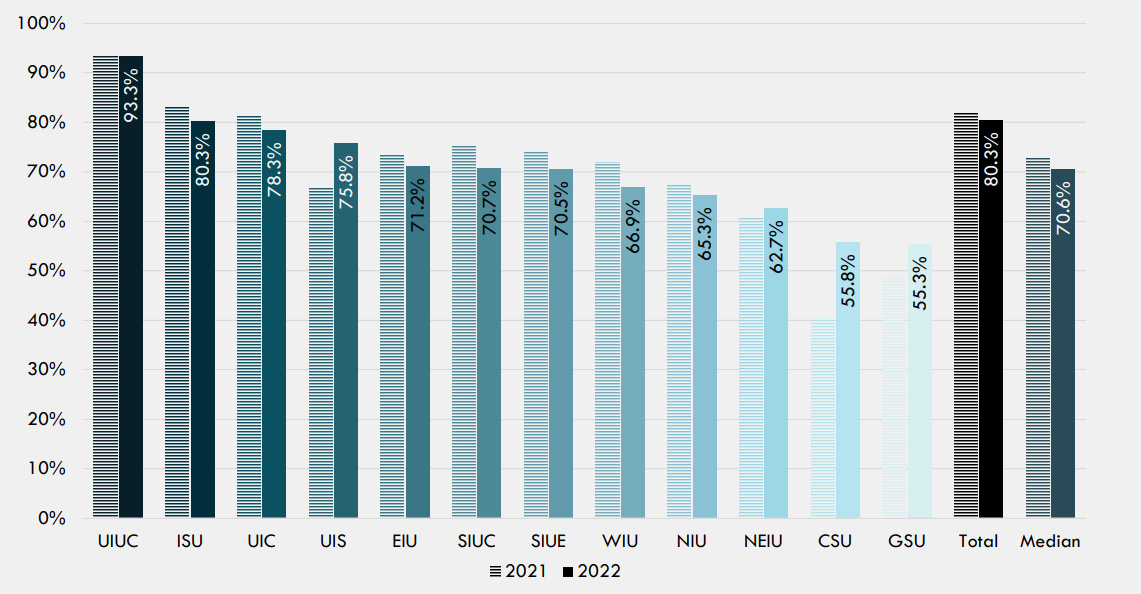
Enrollment by Race/Ethnicity and Gender
African American: African American undergraduate enrollment was mostly flat at Illinois public universities, with males experiencing an increase of 1.8% and females slightly decreasing. However, enrollment of African American freshmen increased by 10.5%, with males experiencing a significantly larger increase at 17.5%. African American males experienced a large decrease in graduate enrollment (-7.7%) driving the overall decrease, while female graduate enrollment was down only slightly (-0.7%).
Asian: Asian undergraduate enrollment slightly increased (+0.8%) at Illinois public universities, with females experiencing an increase (+2.3%) compared with a slight decrease for males (-0.4%). The public universities experienced moderately large decreases in the number of Asian freshmen (-8.9%). There was a large decrease in the number of Asian female transfer students (-20.6%), while Asian male transfer students increased at a rate of 5.1%.
Latino: Latino undergraduate enrollment at Illinois public universities was flat with the number of Latino females increasing slightly (+0.2%) and Latino males decreasing slightly (-0.1%). The increase in Latino freshmen equated to 12.9% growth year-over-year with similar double-digit growth in freshmen among Latino females (+13.6%) and Latino males (+11.9%). The decrease in new Latino transfer students was 5.8% with Latino males and experiencing a slightly larger decrease at Illinois public universities (-7.3% for male related to -4.5% for females).
White:White students experienced enrollment decreases across nearly across all of the enrollment types and gender groups except for freshmen (+2.4%).
International: International students had large year-over-year enrollment increases for males and females across all enrollment types, with only one exception, the slight annual growth among new female transfer students at 1.2%.
Figure 8: Change in Headcount Enrollments at Illinois Public
Universities
from fall of 2021-22 to 2022-23
